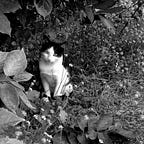On becoming an ouroboros
Ouroboros is an intriguing creature. Legless like an anaconda, it constantly eats its tail, forming a circle like a revolving wheel tumbling in dynamic perpetuation. There must have been a mechanism to prevent its body from shortening. Maybe an existence of a stem cell population at its tail that is never exhausted. Technically, without dropping its tail from the mouth, its body can twist and swirl in the shape of a lemniscate or any other kind of complex topology like a ridiculously intricate knot. Nevertheless, let us keep it simple and circular.
From an embryological point of view, it is pretty odd that no extant vertebrates on earth resemble ouroboros. The closest resemblance is when I find my cat chasing, playing and eating her tail. For a flick of a second, she becomes an ouroboros — a very fluffy one with whiskers, sharp teeth and pointed ears.
For a vertebrate embryo to develop into an ouroboros, its tail bud has to keep extending caudally, perhaps by an overproduction of Brachyury/Tbx6, while the anterior-most cells of its head-forming prechordal plate keep expanding rostrally along the longitudinal body axis until they meet at the mid-ventral position of the yolk sac. By sharing a common ancestor with snakes, both of which lack limb buds, its segmentation clock will tick continuously to form a pair of somites approximately every 100 minutes, with the tail bud constantly supplies somite-building materials. The receding of the Fgf8 wavefront probably needs to be slowed down tremendously to meet the demand of supernumerary somites, making it an extreme example of evolutionary heterochrony. The attrition of somites from the posterior end, eaten by the mouth of an ouroboros, must be replenished by adding new ones. But how can an ouroboros form new somites without its tail bud?
Unfortunately, elongation of the anterior-posterior body axis, bound by the temporal-spatial restrain, is unidirectional — younger somites always form from the posterior end. The zone of self-renewal never sits between two somites. Once it is eaten by the mouth, it is completely gone. The logic of unidirectional development is determined at gastrulation by the ingression of epiblasts from the Mangold-Spemann organiser. Or even earlier at the time of fertilisation which determines the position of the organiser.
Before an embryo attains its archetypical goal of becoming an ouroboros, before it initiates the individuation process to discover the reason for its life, it has to become an individual first. That is, to have its absolute polarity bound by clear demarcation. Now I can see how the ouroboros looks down on us with amusement. Despite a 3-dimensional delusion, from an ouroboros’ viewpoint, we are just planar decoration on earth, as our humble origin at the beginning of our journeys on the surface of the blastocysts.
